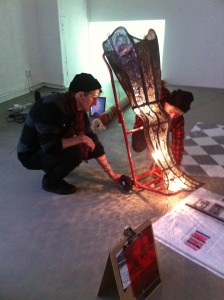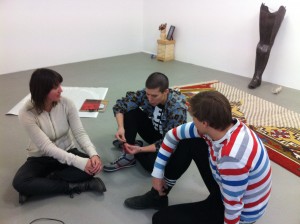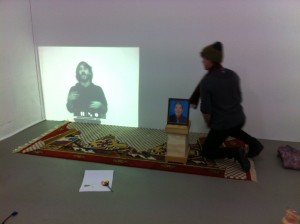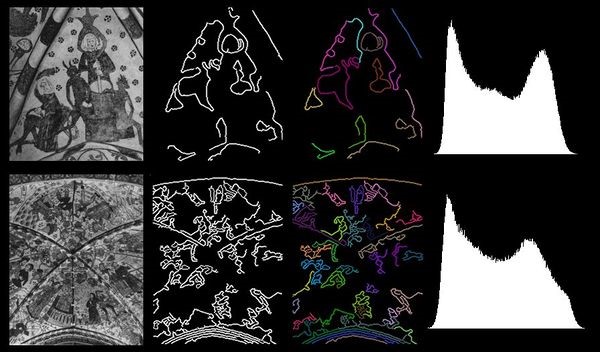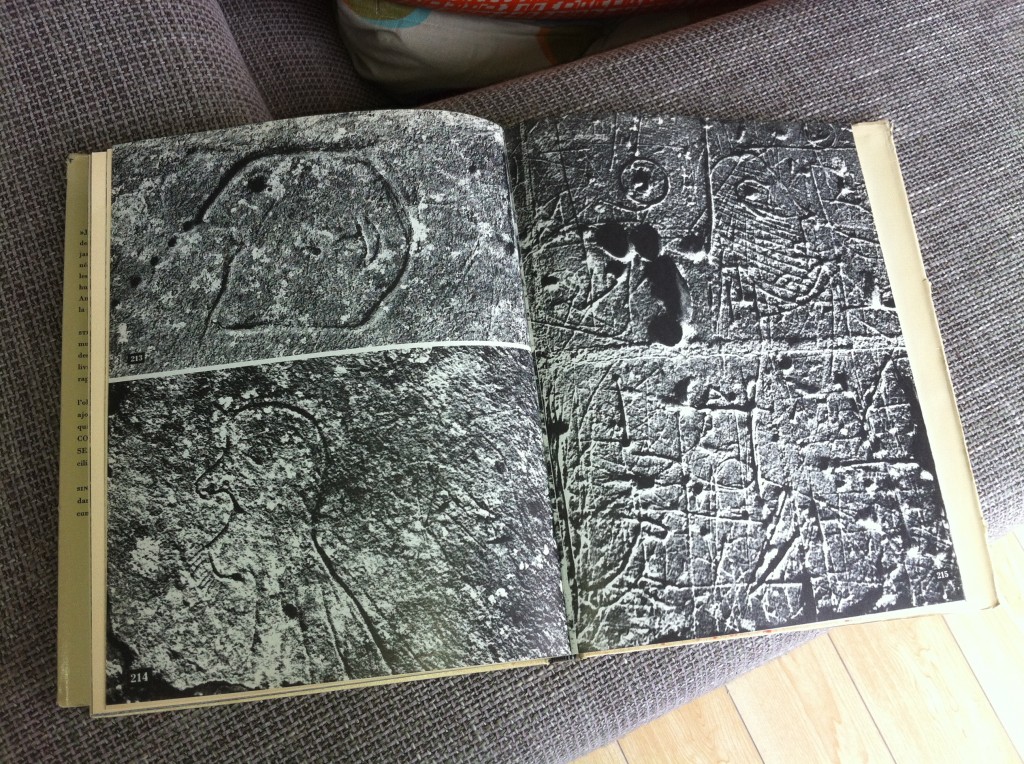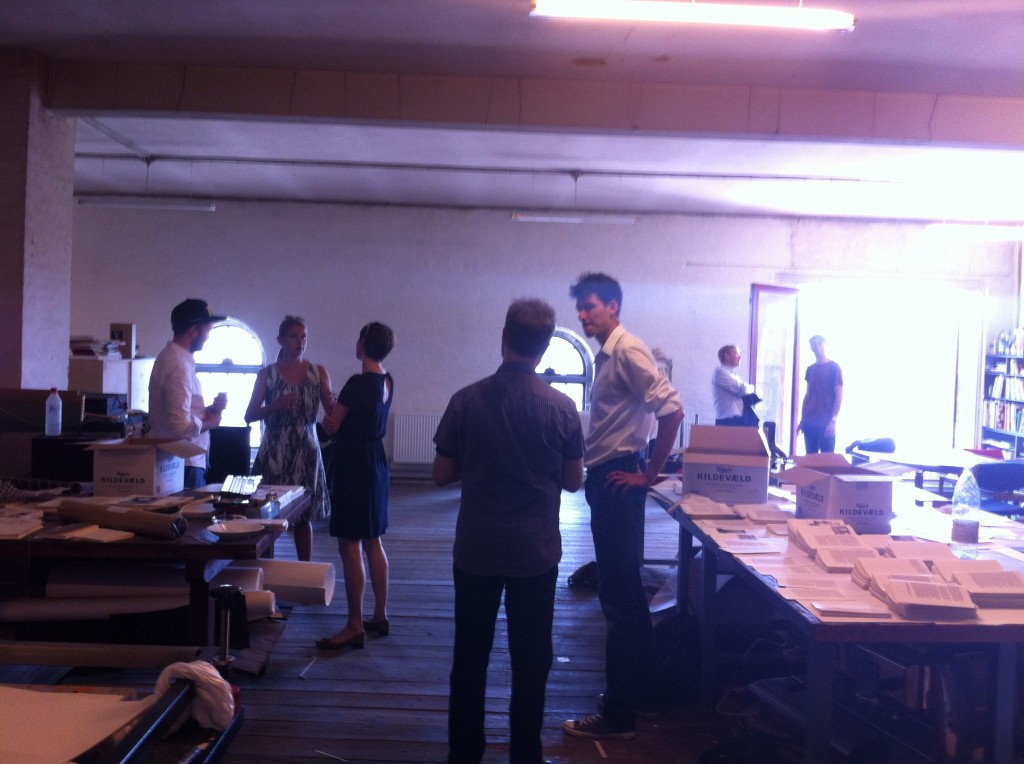KLARA LIDÉN, PILLAR HUGGER
In 2012, when I applied for a so-called mediators grant to support a curatorial research into Jorn’s writing and thinking I played around with the idea to look at the work of the Swedish-born contemporary artist Klara Lidén (1979) through the lens of Asger Jorn’s ideas on vandalism. Now, 4 years later, Zoë Gray, Senior Curator at the centre for contemporary arts Wiels, in Brussels, gave me the incentive to finally do so for a lecture in the framework of the exhibition Klara Lidén: Battement battu (29.10.2015 – 10.01.2016). The text is a slight adaption of the lecture that I held on January 6th, 2016 at Wiels. I would like to thank Zoë Gray, and I would also like to thank a range of art historians and other Asger Jorn specialists whose perspectives have been highly informative to this lecture including Ruth Baumeister, Helle Brøns, Niels Hendriksen, Karen Kurczynski, and Peter Shield.
Asger Jorn
Let me introduce the first one of the protagonists of this lecture in more detail: the Danish experimental artist and thinker Asger Jorn (1914-1973) was one of the founding members of the Danish Høst group (1934-1950) and the associated magazine Helhesten which he founded (1941–44); the international experimental Cobra group (1948-1951); the Movement International for an Imaginist Bauhaus (1953); and the Situationist International with among others Guy Debord (or SI, 1957–1972), and the Scandinavian Institute of Comparative Vandalism (1961-1965).
To Jorn’s own way to go about we could certainly attribute ‘vandalistic’ tendencies: he would cut out images, scribble or underline passages in his own books (as well as in the books of others), he would buy bourgeois, academic style Sunday school paintings at the flea market and alter them, he would for several years in a row go back to the house of the collector of his largest painting to continue altering the painting because the buyer had made a comment about the work perhaps ‘still missing something’, he would run a scooter over a large clay relief leaving the tire track visible in the end result, and he would tear down tick layers of posters in the streets of Paris to ‘décollage’ them.
Even the way that Jorn used photography in for instance his book Signes gravés sur les églises de l’Eure et du Calvados (1964, on mediaeval graffiti on churches in France) has been labelled ‘vandalistic’ for the continuous disconnection of the photographs from historical chronology in favour of a purely visual order (Niels Hendriksen).
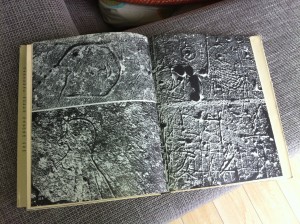
Asger Jorn, Signes gravés sur les églises de l’Eure et du Calvados, 1964
Klara Lidén
Protagonist number two is the Swedish artist Klara Lidén (1979) who lives and works between Berlin and New York. Lidén works with performance, interventions, video, installation and sculpture. Her main interest is an exploration of the physical, psychological and social limits and conventions of both public and private space; the street as an endless source of inspiration and action; an obsession with recycling and transforming urban materials; physical gesture and use of the body. She has recycled waste packaging into makeshift hideaways, turned old posters into paintings, along with many other kinds of creative vandalism.
Like Asger Jorn’s décollages, Lidén’s Poster Paintings series consists of layers of glued-together advertisement posters taken from the streets, but in contrast to Jorn who reveals so to speak hidden compositions, Lidén’s sole addition is a white top sheet. A series of spray-paint works on paper by Lidén show traces, prints of everyday life items that the artist finds in her studio or among her personal belongings, including her bike. Again an image that reminded me of Jorn, of his clay relief.
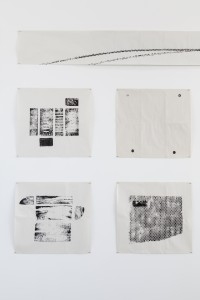
Overview of various works on paper with spray paint by Klara Lidén, exhibition detail, Wiels, Brussels, 2015.
Lidén’s photograph Bowery (2012), showing a figure that has climbed on to a street sign at an intersection; and Column Monkey (2013), in which we see how she ascended on the pillar of a deserted building in an urban zone reminded me of images in one of the publications of Jorn’s SISV.
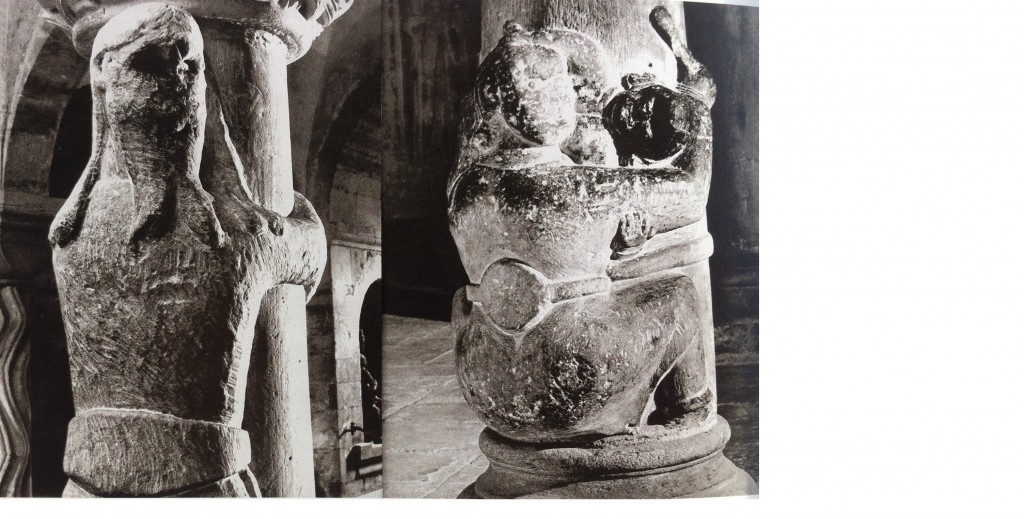
Pillar-breakers or pillar-huggers at Lund Cathedral, photograph by Gerard Franceschi in Jorn’s publication “Skånes stenskulptur under 1100-talet” (12th-Century Stone Sculpture of Scania), 1965.
JORN ON VANDALISM
Not only did Jorn display a ‘vandalistic attitude’ within his own art practice, throughout his writings he also theorized on the concept of vandalism but of course, the concept is part of a web of other notions, and I decided to simply take a few of these as a starting point for further analysis and speculation.
Value
In relation to the notion of value I would first like to bring up the vocabulary of the Situationist International, which happens to be frequently mentioned in relation to Klara Lidén’s work – especially the notion of détournement. Détournement is usually translated into English as ‘diversion’. An English translation of the Situationist publication Détournement as negation and prelude[1] (originally published in French in 1959) says: “Détournement, the reuse of preexisting (artistic) elements in a new ensemble, has been a constantly present tendency of the contemporary avant-garde, both before and since the formation of the SI. The two fundamental laws of détournement are the loss of importance of each detourned autonomous element — which may go so far as to completely lose its original sense — and at the same time the organization of another meaningful ensemble that confers on each element its new scope and effect.”
Artistic examples of detourned expression include Jorn’s previously mentioned modifications, his altered Sunday school paintings. As Karen Kurczynski writes in The Art and Politics of Asger Jorn, with these kind of works “Jorn expressed an overt critique of the social exclusivity of high art from classicism to modernism and beyond.”
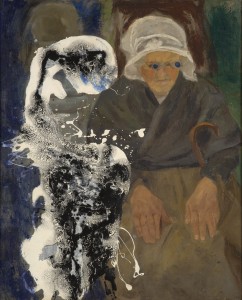
Asger Jorn, Modification with Brittany Woman, 1962. Collection Cobra Museum of Modern Art, long-term loan by Karel van Stuijvenberg,
On the occasion of an exhibition of these type of paintings, Jorn wrote: “In this exhibition I erect a monument in honor of bad painting. Personally, I like it better than good painting. But above all, this monument is indispensable, both for me and for everyone else. It is painting sacrificed. This sort of offering can be done gently the way doctors do it when they kill their patients with new medicines that they want to try out. It can also be done in barbaric fashion, in public and with splendour. This is what I like. I solemnly tip my hat and let the blood of my victims flow while intoning Baudelair’s hymn to beauty.”[2]
But despite this colourful remark, Jorn’s ‘vandalistic’ approach was never aimed at one-dimensional disrespectful destruction. This is also illustrated well by something else Asger Jorn said about his modifications in the same text:
Be modern / collectors, museums / if you have old paintings / do not despair / Retain your memories / but detourn them / so that they correspond with your era. / Why reject the old / if one can modernize it / with a few strokes of the brush. / This casts a bit of contemporaneity / on your old culture. / Be up to date / and distinguished / at the same time. / Painting is over/ You might as well finish it off / Detourn (détournez) / Long live painting.
Contemporary art historians tend to think of the modifications as re-valuations, or as “progressive use of tradition”. As Helle Brøns points out Jorn fully recognized that the creation of new values by devalorization is only possible where there is something to de-valorise, i.e. where a recognized value already exists. Brøns: “There is a fundamental difference between Debord’s attitude to the détourned material as something losing its significance, and Jorn’s maintaining – in part – its original value.”[3]
An artistic example of the use of detourned expression in Klara Lidén’s work could be the previously mentioned Poster Painting series. The posters lose their autonomy, and the reorganization by the simple gesture of adding a blank top sheet undermines their presumed message. The title of these works make a general reference to painting, the blank top sheet suggest a particular reference to the tradition of the abstract monochrome in modernism, the ‘upgrading’ of street posters to ‘high art’ could (as was the case with Jorn) be read as an overt critique on the social exclusivity of high art.
Below, I will discuss the next point that is also intertwined with Jorn’s thinking about vandalism but that leads to a pointing at some fundamental differences in Jorn’s and Lidén’s respective practices.
Progress
In Jorn’s texts the complete freedom required to create pure experiment, and the transgression of existing modes of thinking and pre-established norms and ideas, are inextricably linked to the notions of progress (and risk). In his text ‘Charms and Mechanisms – upon the role of vandalism in the history of arts’ (published in French in 1958 in his collection of essays Pour la Forme (the first substantial publication within the Situationist International) Jorn also brings up the example of the testing of new medicine (like with the detourned paintings when he speaks about “the blood of my victims”). He uses this example to illustrate the fundamental idea that risk, the notion of loss (or potential loss) are in fact an intrinsic part of progress. “I wager this clear idea”, Jorn says: “that there will never be any progress without tragic consequences. The gamble with life is the origin and the price of all progress.”[4] In other words: all progress is vandalistic and barbaric.
So what else does Jorn’s perspective on progress entail? In Charms and Mechanisms he states that he believes in progress, but that as an artist he rejects “any ethical interpretation of progress understood as moving towards happiness, justice or whatever.”[5] Jorn’s rejection of this interpretation might have been influenced by the Danish philosopher Kierkegaard, whose writings Jorn was very familiar with, and who belongs to a generation of thinkers who, I quote the Finnish philosopher Georg Henrik von Wright: “in the course of the nineteenth century had clearly distanced themselves from the idea of the myth of progress” and who according to Von Wright were “not necessarily pessimistic but in a sombre mood of self-reflexion and questioning of dominant currents of their time.”
Based on this more critical attitude, Jorn’s take on progress is instead, I quote: “(…) simply the feeling one has when one moves forward, on a train, for example, and sees the countryside disappear in the opposite direction. The feeling of progress implies losing something while gaining something else.”[6] “It is only by change, that is to say by movement, that the notion of time is available to us … If there are no events there is obviously no sequence, and consequently no time.”[7] According to Jorn, it is the direct goal of the arts to create these events – it is the speciality of the arts to do so. In his own practice this meant that he always aimed to create what he called “the greatest sensorial significance” by varying and diversifying processes.
Despite his rejection of the idea that progress necessarily implies improvement, one of Jorn’s motivations to write Charms and Mechanisms stems from a concern over the declining power of the human race to evolve. In our struggle for reason, we are abandoning this power, Jorn says, by “giving up all irrational or artistic activity in the sphere of the imagination” – whereas it is exactly this activity that generates new knowledge, artistic knowledge[8] (which Jorn also refers to as “comprehension without recognition”).
The Myth of Progress
Klara Lidén has been preoccupied with the notion of progress as well, as is illustrated in the titles of some of her works and the title for her solo exhibition, at the Irish Museum of Modern Art in Dublin in 2014: The Myth of Progress. She took the title from an essay by the aforementioned Finnish philosopher Georg Henrik von Wright (1916 – 2003).
As Jacques Bouveresse points out in his article ‘Wittgenstein, von Wright and the Myth of Progress’[9] Von Wright wasn’t critiquing progress itself, but critiquing the idea that progress is unbounded and everlasting, natural and necessary, and that this type of progress is inscribed in the nature of human beings as a species. Bouveresse quotes Von Wright: “(…) we may seriously wonder whether the idea of unlimited progress, understood in such a way, is not liable to enter into contradiction at some point with the natural species itself, which necessarily implies an environment and living conditions which must also remain, at least to a certain extent, natural, and cannot be transformed in any way we could like and without any limits.”
In contrast, Asger Jorn is aware of the risks that come with progress (its ‘vandalistic’ aspect), but accepts the risk, while maintaining a desire for, or a belief in progress. In his artistic practice this translates into an experimental working method based on bringing about variation and diversification. Large parts of his artistic output, consist of taking existing elements and altering them, resulting in a new objects that now say something else. Think of his modifications, or of his décollages.
In comparison Klara Lidén, who we could argue lives in a world that starts showing the actual consequences of unlimited progress, seems to add just the minimum to a world already overloaded. There is a stronger focus on conceptual, minimal gestures such as with the stacked pieces of asphalt, or with the Poster Paintings: when Klara Liden takes a thick layer of posters from the street and alters it, strictly speaking, she doesn’t add another/her own voice, she rather mutes the original message.
Or, where Lidén leaves a modest bike tire trace on a piece of paper, Jorn leaves behind the noisy tire track of a scooter on the largest clay relief in Europe (27 meter); where Jorn has written hundreds of texts and engaged in public discussions, I can only find a modest amount of interviews by Klara Lidén, and where Jorn co-established various artist groups all trying to raise their voice, always discussing and debating, also amongst themselves, we see Klara Liden on her own, or as a solitary individual even if amongst a group of other people (such as in her well-known video Paralyzed, 2003, in which she does a wild, uninhibited dance on a commuters train in Sweden). In conclusion, I would like to speculate that it is perhaps Jorn’s and Liden’s respective perspectives on the notion of progress are accountable for these kind of differences in their artistic output.
I will now jump to the last notion that is closely related to Jorn’s ideas on vandalism, which is the notion of resistance.
Resistance
From an intellectual point of view Jorn was interested in vandalist expressions as acts of resistance against the reigning order: the graffiti that he found on the churches in France was supposedly made by Viking “vandals”, and the book 12th Century Stone Sculptures of Scania is emblematic for the SISV approach by demonstrating a subtle subversion of the iconography of power. This aforementioned book which includes the image of the pillarhuggers/breakers traces the infiltration of a non-Christian iconography of beard-pullers, double-heads and pillarhuggers in the decorative programs of churches built in the aftermath of the annexation of Scania by the recently converted kingdom of Denmark around the year 1000.
The subversion of existing hierarchies and power relations runs through Jorn’s thinking and practice as a red thread. In Charms and Mechanisms, when Jorn speaks of what distinguishes the artist from “his adversary” he characterizes the artist as the one with conscious opposition to the reigning order in life and places what the calls the “grotesque folly of a too probable existence played out in advance” in direct opposition to the “pure desire for the unexpected, the thirst for surprise, the longing for the absurd, and the attraction of the abnormal, in short, towards diversion, amusement, the ‘dérive’.[10] And a bit further on he writes: “all artistic structurations are just different forms of networks of resistance against movements. (…) all we need to point out here is that artistic currents cannot, as imagined by politicians, serve directly to unify and accelerate general social movement. On the contrary, as counter-currents they are engaged in enriching, diversifying and enlarging the importance of an existing movement by diverting it.”[11]
What speaks from these citations is Jorn’s love for dialogue between a plurality of voices, which is not only part of his thinking, it is also expressed in the collaborations that he was always looking for. To Jorn the dialogue with others, whether harmonious or conflicting, was never supplementary or subsequent, but foundational to his practice and the way he dealt with art as a public phenomenon. Within these collaborations Jorn was fiercely opposed to watered-down consensual results. He believed that consensual strategies needed to be avoided in order for everyone involved to give their very best. The dialogues that Jorn was looking for, were of a more polemic, combative nature. In contemporary terms we could perhaps even speak of Jorn’s attitude as agonistic. “Within agonistic theory disagreement and disputation as deemed necessary, rather than negative components of political and social life”, they are considered “constituents that are at the foundation of an active, vigorous instantiation of citizenship. Within this conception of the public sphere no boundaries or borders can remain unchallenged.”[12]
In conclusion we could say that Jorn, who despite his statement about the rejection of an ethical interpretation of progress, is still driven by the idea that artists and architects could potentially make a difference, testifies of a resistance that is so to speak ‘loud’. In contrast Lidén’s seems a mute resistance, perhaps even totally devoid of risky dreams of a better world. As Helen Molesworth writes in an excellent article in Art Forum when discussing Lidén’s practice: “the artist at work is imaged as silent, sullen, solitary, and quite possibly self-defeating.”[13] Molesworth speaks of a “muted, nearly autistic sensibility” in relation to Lidén. But what does that imply in regards to the notion of resistance, of critique in her practice? Obviously she is not looking to argue, to engage in an active, vigorous instantiation of citizenship ….
Perhaps we should take the term postcritique, a notion that was brought up by Helen Molesworth in the same text, into consideration. The way I understand the term postcritique (though admittedly based on very limited knowledge), suggests that Lidén belongs to a generation that is critical of universal normative principles. A generation that as such is not primarily concerned with these, whereas nevertheless looking for the possibility of critical resistance to moral and social ills. However, as David Couzen Huoy points out in his book Critical Resistance – from Poststructuralism to Postcritique the type of resistance, the in-your-face refusal, exemplified by the famous students uprisings in Paris in May 1968, in which the Situationists International played such a preponderant role (to some extent their political perspective and ideas fueled such crisis), has been replaced by another. The ’68 motto “we are realists, we demand the impossible” nowadays simply means “to resist globalization of capitalism even when one does not have a better alternative to offer” (here Huoy sketches the perspective of Slavoj Zizek).
This perspective might offer an explanation of why Florence Waters in a 2010 review in the Telegraph on Klara Lidén’s solo show at the Serpentine Gallery felt compelled to write that it: “(…) is the knowing futility of Liden’s gestures that separates her from the previous generation of art vandals.” And that, “Unlike her forefathers, Liden’s message is too suffused with irony to be political. She seems, almost, to be poking fun at her predecessors (…) for the naivety of the idea that art would be grand enough to really change anything.”[14] Also Helen Molesworth discusses some of Liden’s works as “the staging of what may be the central dilemma of today’s emerging artist: the futility of being one in the first place.” She writes: “And spending time with her work, one realizes that the twentieth-century paradigm of art’s utopian aspirations is not what’s at stake. Lidén offers blankness—and its aural handmaiden, muteness—less as a critique or a way out than as a condition, less as a program than as a given (reduce, reuse, recycle). In her work, I sense a tacit acknowledgment that the jig is up, that being an artist is just another way of getting by, a coping strategy for living under late capitalism.”[15]
Perhaps this ‘just another way of getting by attitude’ (I’m sure that I’m making it sound more negative then Molesworth intended) is a justified observation. I can see why it would be. I can then also see how this attitude is ground for critique that was expressed in a review in Frieze of a group show in which Lidén was participating. In the article some of her work, as well as that of some other artists, was criticized the following way, I quote, “the pointing towards resistance and subtle undercurrents of violence became the objects of aesthetic contemplation.
This was palpable in Klara Lidén’s series of framed black and white photographic prints, including Untitled (Down) (2011) and Untitled (Monkey) (2010). In these images, a distant person traces alternative routes through the city, up concrete pillars and down manholes. These works did not merely speak of an aesthetic of revolt, but also of the fetishization of resistance.”[16]
But I am having a hard time to buy the ‘just another way of getting by attitude’. Perhaps I simply find it too depressing, but I also guess that there are much much easier ways of getting by then being an artist. And funnily enough, the works criticized in Frieze magazine, are pretty much the same works that led Darran Anderson in a passionate and positive review of Lidén’s solo exhibition at IMMA to conclude that she “demonstrates that we can resist through small imaginative acts of revolt, or at least express our alienation.”[17] Anderson brings up the humorous aspect of the work, as well the notion of danger and risk (public ridicule, attention of authorities, physical harm). And he speaks of how in these works, Lidén’s presence in public space communicates that “any attempt at individuality or real interaction with the surroundings will have stern and immediate consequences”. Crucially, Anderson also adds that “Critically, these are unspoken warnings, existing already in our own heads.”
So what perhaps primarily becomes obvious from Anderson’s observations, is that we are not looking at an artist who is ironic up to the point where the work stops being political, or whose artisthood is just another way of getting by. Lidén belongs to a generation that knows too well (to quote from David Huoy’s book) “that domination and resistance are intimately related to each other, that perception of social constraints is itself produced by social constraints, and thus is just as likely to perpetuate these constraints as to escape them.” What seems to be ‘just another way of getting by’ might in fact be a constant struggle, a way to resist the pitfall of not recognizing that “power and domination may (…) be more complex than it appears on the surface, that the social features that are being resisted may produce the shape that resistance takes.” (Huoy uses the example of a teenager who imagines a world without parents is in fact still presupposing the subject identity teenager and therefore the same social organization that is resented).
In that sense we could think of Lidén’s strategies (the muteness, the solitary acts, the ironic humor, the use of her own body) as highly politically informed strategies all aimed to create “latent and subversive relationships to representation” (as Carl Kostyal expressed it in the same Frieze review on a more positive note on Lidén’s work). I would like to think of Lidén’s repeated performance or embodiment of the pillarhugger/breaker (coming from Sweden she might very well know the mediaeval predecessors in the Lund cathedral) as emblematic for her interest in subversive relationships to representation.
With Column Monkey and similar works, Lidén expresses an interest, like Jorn had, in a transformation of the inorganic to the organic function, challenging the fundamental, static character of architecture. And as Niels Hendriksen points out in his article on Jorn’s Scandinavian Institute of Comparative Vandalism, things and beings that are in a state of transformation inherently hint at subversive relationships to representation, as they hint at cultic metamorphosis, in which value is mutable, where dragons, fish, and other creatures are turned into princes and princesses who in turn become deer, birds, and ghosts. This conflicts with the Judeo-Christian metaphysical world order that stands above nature and matter, and in which (in Christian iconography) the stability of animal symbols serves to perpetuate societal hierarchies.[18] Unlike Asger Jorn though, Klara Lidén is not only interested in investigating the subversive nature of the representation of metamorphosis: by making use of her own body, she becomes the pillarbreaker.
[1] The full text can be found here http://www.bopsecrets.org/SI/3.detourn.htm
[2] Asger Jorn, ‘Detourned Painting’, in: Hvad skovsøen gemte / Jorns Modifikationer & Kirkebys Overmalinger, Museum Jorn, Silkeborg, 2011, p. 132-133.
[3] Helle Brøns, ‘The Shock of the Old’, in: Hvad skovsøen gemte / Jorns Modifikationer & Kirkebys Overmalinger, Museum Jorn, Silkeborg, 2011, p. 136.
[4] Asger Jorn, ‘Charms and Mechanisms – upon the role of vandalism in the history of arts’, in: Concerning Form – an outline for a methodology of the arts, Museum Jorn, Silkeborg, 2012.
[5] ‘Charms and Mechanisms’, p. 107.
[6] ‘Charms and Mechanisms’, p. 107.
[7] ‘Charms and Mechanisms’, p. 108.
[8] ‘Charms and Mechanisms’, p. 109.
[9] Paragraph, volume 34, issue 3, page 301-321, ISSN 0264-8334, Available Online November 2011. The full article can be found here: http://dx.doi.org/10.3366/para.2011.0027
[10] ‘Charms and Mechanisms’, p. 112/113. Dérive is a mode of experimental behaviour connected to the conditions of urban society: a technique (used by the Situationists) of transient passage through various ambiences.
[11] ‘Charms and Mechanisms’, p. 117.
[12] Rafael Schacter, Ornament and Order – Graffiti, Street Art and the Parergon, Ashgate, 2014, p. 95.
[13] Helen Molesworth, ‘In Memory of Static’, in: Artforum, March 2011, p. 217.
[14] The review can be found here: http://www.telegraph.co.uk/culture/art/art-reviews/8056879/Klara-Liden-Serpentine-Gallery-review.html
[15] ‘In Memory of Static’, p. 222.
[16] Carl Kostyál, Awaiting Immanence, in: Frieze, Issue 157, September 2013. The review can be found here: http://www.frieze.com/issue/review/awaiting-immanence/
[17] Darran Anderson, ‘Klara Lidén: The Myth of Progress’, in: Studio International, 18/11/2013. The review can be found here: http://www.studiointernational.com/index.php/klara-liden
[18] Niels Hendriksen, ‘Vandalist Revival: Asger Jorn’s Archeology’, in: Asger Jorn, Restless Rebel, Statens Museum for Kunst, Copenhagen, 2014.
PILLAR HUGGERS – A WORKSHOP AND EXHIBITION AT OR GALLERY, BERLIN
with Antonis Pittas, Johann Arens, Jay Tan, Klaus Weber, Christoph Keller, Hilde de Bruijn, Shannon Bool, Hadley+Maxwell
January 23 – April 18, 2015
Reception Friday, January 23, 7:30PM
Curated by Hilde de Bruijn, Shannon Bool and Hadley+Maxwell
The Danish experimental artist and thinker Asger Jorn (1914-1973), well-known as one of the driving forces of Cobra (1948-1951) and L’Internationale Situationniste (1957-1972) was a fierce collaborator, always looking for international exchange and discussions, facilitating collective work, magazines, and exhibitions. With great drive and ambition Jorn also wrote numerous books and articles envisioning, from an artistic point of view, ‘the first complete revision of the existing philosophical system’. Jorn believed that art is not derived from an ideology or worldview, but is the direct expression of an attitude towards life, belonging to the fundamental level of work and production. In line with this, Jorn combined in his writings ideas from a wide range of disciplines including politics, physics, economics, philosophy, anthropology, structuralism and art theory. He brought these various interests together via unconventional methods and in a vast variety of forms, in search of a comprehensive theory of art and life.
The architectural figure of the pillar-hugger as it appears in Jorn’s 12th Century Stone Sculptures of Scania1 represents a character whose body has become petrified while attempting to tear down a Cathedral by its vertical supports. A small group of artists have been invited to occupy the position of Pillar Huggers for a one-day visual symposium at Or Gallery Berlin where their work will form the material of their conversation. Transposing Jorn’s definition of a materialist attitude toward making art (as he articulates in the essay ‘What is Ornament’ (1948)) to exhibition-making, the artists are asked to animate the position of the body who, through its transformation into the inorganic, becomes the support for the very same edifice it attempts to destroy. How can we reconcile the compulsion to ornament with a resistance to the compulsion to make an exhibition? Can we avoid the exhibition as monumental decoration by approaching the encounter of and between artwork with the spirit of Jorn’s conception of vandalism and the spontaneous arabesque?
The remnants of the workshop opened to the public at 7:30 pm on January 23, 2015, and have also resulted in the visual essay What is Jornament? (published on this blog). The text is taken from the book Fraternité Avant Tout – Asger Jorn’s writings on art and architecture, 1938-1958. Editor: Ruth Baumeister. Translator: Paul Larkin.
Publisher: 010 Publishers.
—————
[1] The book traces the infiltration of a non-Christian iconography of pillar-huggers, beard-pullers, and double-heads in the decorative programs of churches built in the aftermath of pagan Scania by the recently converted kingdom of Denmark around the year 1000.
About the artists:
Klaus Weber is an artist, who lives and works in Berlin, he has shown extensively in both Europe and the United Sates. He conceives works across a variety of media and spatial units, which are often based on multifaceted technological interconnections and intricately organized production processes. Yet, by purposely manipulating everyday structures, the tracing of deviations and the exploration of the impossible, they undermine the metaphorical and actual power of a functionalist rationality. In doing this, Weber repetitively uses images of nature, and explores the sustainable potential of the untamable in a humorous and anarchic manner. Weber has had institutional solo shows at the Fondazione Morra Greco in Naples, the Nottingham Contemporary, the Secession in Vienna, the Hayward Gallery in London, as well as the Kunstverein in Hamburg. The artist has participated in group shows at the MOCA, Los Angeles, the Mori Museum in Tokyo and at the KW Institute for Contemporary Art, Berlin. Weber is represented by Andrew Kreps Gallery in NY and Herald St Gallery in London.
Shannon Bool (1972, Canada) originally from Vancouver Island, she attended Emily Carr University before studying in New York, Frankfurt and moving to Berlin were she lives and works. Solo exhibitions include: The Fourth Wall Through the Third Eye, Galerie Kadel Willborn, Düsseldorf; Walk Like an Etruscan, Daniel Faria Gallery, Toronto (2013); The Inverted Harem II, Bonner Kunstverein (2011); CRAC Alsace, Altkirch, France; The Inverted Harem, GAK-Gesellschaft für Aktuelle Kunst, Bremen (2010); RMIT Project Space, Melbourne, Australia (2008). Group exhibitions include MMK2 Boom She Boom, Works from the MMK Collection, Frankfurt; The Klöntal Triennale, Kunsthaus Glarus, Switzerland (2014); Soft Pictures, Fondazione Sandretto Re Rebaugengo, Turin; Painting Forever!, KW, Berlin; Justina M. Barnicke Gallery, Toronto (2013); the Sprengel Museum, Hannover (2012); 7×14, Kunsthalle Baden-Baden; Tactical Support, Gallery Tracy Williams, New York; Rock Opera, CACP Museum of Contemporary Art, Bordeaux (2009); Drawing on Sculpture: Graphic Interventions on the Photographic Surface, Henry Moore Institute, Leeds (2007); Make Your Move, Projects Arts Centre, Dublin; Spiralen der Erinnerung, Kunstverein in Hamburg; Carbonic Anhydride, Galerie Max Hetzler, Berlin (2006). Work is held in the collections of Berlinische Galerie Landesmuseum Fur Moderne Kunst, Fotografie und Architektur, Berlin; MMK Museum fur Modern Kunst, Frankfurt am Main; Lenbachhaus, Munich, and the Saatchi Collection, London. She is represented by Kadel Willborn Gallery in Düsseldorf and Daniel Faria Gallery, Toronto.
Johann Arens (born in Aachen, Germany 1981). He uses installation and video to survey the documentary properties of public interiors. By systematically re-editing the hardware of a location he draws up an abstract inventory of the social textures inherent in the site. His work is an enquiry into the role of human interfaces, the desire to touch artefacts and the mechanisms of user behaviour. After graduating from the Gerrit Rietveld Academy in Amsterdam, he received a stipend by the Netherlands Foundation of Visual Arts to complete his MFA in Fine Arts at Goldsmith, University of London. Since then he has worked on public commissions assigned by Arnolfini / Art and the Public Realm, Bristol, Letchworth Heritage Foundation and Jerwood Foundation London. In 2013 he has been awarded the Rome Fellowship in Contemporary Art by the British Academy and has recently started his residency at the Rijksakademie in Amsterdam.
Recent solo shows include ‘Internet Centre & Habesha Grocery’, Paradise Row, London; ‘Apple and Pear’, ASC Gallery, London; ‘Effect Rating’ De Service Garage, Amsterdam. Recent group shows include ‘New Contemporaries’, ICA London; ‘No Soul For Sale’ Festival, Tate Modern, London; ‘A useful-looking useless object’,Sierra Metro, Edinburgh; ‘I’ll explain you everythiinnngggg’, Chert, Berlin; ‘Hard Copy’, Pastificio Cerere, Rome, 2014 and ‘TTTT’, Jerwood Space, London.
Antonis Pittas (1973, Greece, lives and works in Amsterdam). As an artist, he mainly creates context-sensitive spatial installations, which are in formed by architecture, art-historical references, the performative aspects of installation art, and its social dynamics. Recent solo exhibitions, include: montage at Annet Gelink Gallery, Amsterdam, 2014, Performing Silence De Nederlandsche Bank (DNB), 2013, Amsterdam, Retroactive at the Hessel Museum of Art & CCS Galleries Bard College, NY, 2011/2012, Landart at the Benaki Museum, Athens, 2012, Untitled (this is a historic opportunity for us), at the Van Abbemuseum in Eindhoven, 2010, Next to his art practice, for the last seven years Pittas has been a teacher at the Rietveld Academie in Amsterdam, in 2014 semester professor in university of Hildesheim in Hildesheim as well as a guest teacher in many academy’s in Europe and U.S, Antonis Pittas is represented by Annet Gelink Gallery, Amsterdam
Jay Tan (1982, Croydon, UK, lives and works in Amsterdam) often uses hobbyist approaches and materials in her sculptures, installations and performances, to produce works in which tactility and basic mechanics perform key roles. We are participants in complex choreographies (histories, politics) where the most measurable properties and forces of the material world produce, fold into, collide with and emerge from our laws, languages and loves. Jay graduated from the Master of Fine Art Programme at the Piet Zwart Institute, Rotterdam in 2010. She has recently participated in group shows at Holly Bush Gardens, London, Karst Gallery, Plymouth, Camden Art Centre, London and PLAYTIME, the Rennes Biennale. Solo presentations include “The Work is Spun…”Rongwrong, Amsterdam, “The Retired Engineer” at the Witte de With Centre For Contemporary Art, Rotterdam and “You Can Stand and Watch Or Spar” Trapéz Gallery, Budapest. She is currently a resident at the Rijksakademie van Beelende Kunst, Amsterdam
Hilde de Bruijn (1971, NL, lives and works in Amsterdam) is a freelance curator and a curator at the Cobra Museum of Modern Art, Amstelveen. Her main freelance activity at the moment is a curatorial research into the writing and thinking of Asger Jorn (1914-1973) which builds a starting point to re-think issues in contemporary artistic and discursive practices – see also www.hildegoesasger.org. She is the co-editor of ‘ Archive Crisis’ , an artists´ book by Stefanos Tsivopoulos, designe Node and to be published by Japsam Books in Autumn 2015. Between 2007 and 2010 she was Head of Exhibitions at SMART Project Space, Amsterdam. She was an advisor for the NL Film Fund, the Mondriaan Foundation and City of Utrecht.
Hadley+Maxwell (artists duo since 1997, Canada, live and work in Berlin). Hadley+Maxwell’s installations, performances and writings, employ diverse media to rework iconic images and traditional forms as they are expressed in pop-cultural, artistic and political movements. They cut into reified narratives via direct touch, transposition and refiguration, putting into play the absences cast in relief.
Hadley+Maxwell have been collaborating since they met in Vancouver, Canada, in 1997. Public presentations of their work have included solo exhibitions at Artspeak (Vancouver), Contemporary Art Gallery (Vancouver), Künstlerhaus Bethanien (Berlin), Kunstverein Göttingen (Germany), Smart Project Space (Amsterdam), and Project Art Centre, Dublin, and group exhibitions at galleries and festivals including the Vancouver Art Gallery, Kunstraum München, the Power Plant (Toronto), the National Gallery of Canada, Taipei Fine Arts Museum, the Seattle Art Museum, La Kunsthalle Mulhouse (France), Witte de With (Rotterdam), the 4th Marrakech Biennale and the 19th Biennale of Sydney. They are represented by Jessica Bradley, Toronto, and live and work in Berlin, Germany.
Christoph Keller, born 1967 in Freiburg/Breisgau, studied Mathematics, Physics and Hydrology in Freiburg, Berlin and Santiago de Chile, at the University of Arts, Berlin and at the Academy of Media Arts, Cologne. Selected solo exhibitions and projects include: Small Survey on Nothingness, Schering Stiftung, Berlin (July 5 – October 4, 2014);Expedition Bus – Shaman Travel, Presentation at abc Berlin (2012); Aether between cosmology and consciousness, Nouveau Festival Du Centre Pompidou, Paris (2011); Voyages Extraordinaires, CRAC Alsace Lorraine, Altkirch (2010), Observatorium, Kunstverein Braunschweig (2008).Recent group exhibitions include: Realität und Fiktion, Villa Schöningen, Potsdam (2013); Ghostbusters – or how to stress photography, Kunsthal Charlottenborg, Copenhagen (2013); Virtuosity – A concert on skill and disruption, strength and nonchalance, morale and cheating, Berliner Philharmonie, Berlin (2013); L’Institut des archives sauvages, Villa Arson, Nice (2012) and The Worldly House, Archive for dOCUMENTA (13) (2012).
The exhibition at Or Gallery took place in collaboration with the Embassy of Canada.
SISSV: AN EXPERIMENTAL APPROACH TO THE ARCHIVE OF THE SCANDINAVIAN INSTITUTE OF COMPARATIVE VANDALISM
The entry below is an email exchange that took place after a workshop in the framework of hildegoesasger at Officin (Copenhagen) where Niels Henriksen presented his research on Asger Jorn’s Scandinavian Institute of Comparative Vandalism (SISV) and Ellef Prestsæter together with Nicolas Malevé presented the work in progress of the Scandinavian Institute of Contemporary Comparative Vandalism (SISSV), an experimental art/research project engaging with the archive of the SISV at the Museum Jorn.
Niels Henriksen is a Ph.D. candidate in the Department of Art and Archaeology at Princeton University, USA. He is currently preparing a thesis on the adaptation of archaeological concepts and procedures in Asger Jorn’s book projects and paintings from 1948 to 1965.
Ellef Prestsæter is an independent researcher, artist, and curator. He is a founding member of the SISSV, together with Michael Murtaugh and Nicolas Malevé. He works at the University of Oslo and writes regularly on art and literature for Klassekampen, Vinduet and Kunstkritikk. Most recent publication: The Invention of the Bright Day by José de Almada Negreiros, translated from the Portuguese into Norwegian and Reports from the Gutenberg Galaxy (http://www.obs-osv.com/gutenberg).
Asger Jorn founded the Scandinavian Institute of Comparative Vandalism (SISV) in 1961, shortly after leaving the Situationist International. Jorn published a series of theoretical “reports of the SISV” and planned the production of some thirty volumes of coffee table books devoted to 10,000 Years of Nordic Folk Art. Eventually only a pilot volume on 12th Century Scanian Stone Sculpture was published. An archive consisting of more than 25,000 negatives taken by Gérard Franceschi and Ulrik Ross (commissioned by Jorn) bears testimony to the magnitude of the endeavor.
NH: My first question regards your framing of your intervention this summer with the SISV in terms of a sort of manual for operating the archive. I am interested in the structures you identified in the original archive, and how you chose to engage with them.
EP: When we started working with the SISV archive at Museum Jorn in Silkeborg, the first thing we needed to do was to develop an understanding of how the archive works, to map the relations, conjunctions and affordances[i] of the archival apparatus. There are more than 25,000 negatives in the filing cabinet. They are all ordered according to geographical location. The corresponding contact sheets as well as enlargements are indexed with a code unique to each image. Thus this image of a wooden stool, to take a random example, is indexed as N7-2-29. N indicates Norway, 7 means that the image was shot in the county of Oppland, 2 gives the further geographical specification of the Gudbrandsdalen valley and 29 is the number given to this specific image.
The key to all of this is a document we refer to as the “white binder”. The binder was produced in the 80s by Stephanie Nørgaard, who was given the task of cleaning up the archive and has been an invaluable source of information for us. Interestingly, she told us that in order to crack the code of the index, she would start with Jorn’s published books (where some of the photos were reproduced) and work her way backwards to the photo archive, reverse-engineering the image articulations of the book, so to say … The white binder maps the overall structure of the repository very well. However, it does not encompass all the material remains of the SISV. Working with the images, Jorn would select the images he wanted to use for some purpose and put them in boxes. Later he would order the images in a particular sequence by putting them into albums that served as mockups for the planned books. A large number of images have been preserved in both “states” of ordering: there are more than 50 boxes and a number of albums. The boxes and albums are not stored in the filing cabinet (indeed they are usually stored in a different part of the museum building; our exhibition at the Museum Jorn this summer brought them into proximity with each other as we moved everything into one room). The boxes and albums bear witness to different stages of Jorn’s work with the images, or so it would seem. Each box and album contains a typewritten sheet where someone (Stephanie says it wasn’t her) has duly indexed its contents, adding a brief annotation of the depicted object. N7-2-29 for instance, appears in an album indexed as Modern times. Volume 6. The common people’s art of wooden images and wooden architecture and has been given the following annotation: “Lillehammer Folk Museum, Norway. A stool with three legs, made of a piece of wood resembling a snake. ?+” The question marks multiply in these annotations.
Most of the boxes are indexed with speculations as to what volume of the 10,000 years of Nordic Folk Art series Jorn had in mind for the selection. The word “possibly” occurs very often: “Hunters’ art. Possibly Antiquity volume 1”. The indexing remains hypothetical, a series of speculations. For us there is something attractive about being able to archive according to hypothetical connections (this is typically what you would want to avoid when setting up a relational database). At the same time, these annotations can be seen as problematic in the sense that they have been made with the book project as sole interpretative grid, with the presupposition that all the orderings can be explained with reference to that project.
This raises the tricky question of whether the SISV can be reduced to the Nordic book project only. This is a widespread assumption, held by, for instance by the art historian and former director of Museum Jorn Troels Andersen, who has engaged deeply with the archive over the years and even published six volumes based on Jorn’s maquettes. But what then, do we make of all the images from Spain, France and Italy? Are they not related to the SISV? In addition, the filing cabinet contains 39 albums with images sorted according to motifs. They include images from the SISV repository as well as from other sources (museums etc.) and date from around 1970 (they were taken to the archive from Jorn’s house in Colombes after his death). These images are by no means restricted to the Nordic sphere. Are these orderings unrelated to the SISV project?
NH: I wonder if you think it is possible to conceive of Jorn’s conceptualization of the archive in relation to his proposed publication series of 10.000 Years of Nordic Folk Art in terms of an apparatus and a manual? What would that imply?
EP: Your questions suggest an intriguing reversal: the image articulations based on the photographic repository preceding it somehow working its way into the latter’s structure, reordering it as its operative manual. Interestingly, such a movement, where a particular use of an archive would feed back into it and transform it is exactly what this archive cannot accommodate. It is significant that whereas you can always trace an image back from one of the boxes or albums to the “archive proper” (the filing cabinet) by means of the code written on the back of most prints, it does not work in the other direction. Looking up an image in the filing cabinet will not point you in the direction of its previous use, whether it has been selected for one of the boxes/albums or appeared in books etc. A book such as the one on the stone sculptures of Scania can only work its way back into the archive as a new document, given a unique location in the archive (indeed there is a folder in cabinet 7.4 containing most of the images selected for the book as well as documents specifying their sequence in the book).
On another level, the sequences and selections developed by Jorn do serve as suggestions as to how the images in the repository might be handled. As such they are perhaps better described as examples rather than manuals in the strict sense. Jorn explicitly made clear that his orderings were not definitive or exhaustive. In one of the texts you translated for October magazine, he states that “the publication of the series “10,000 Years of Nordic Folk Art” should be a historic event in itself, in the most proper sense of the term, meaning a temporally limited phenomenon that could soon be replaced by another series, composed in a different way” (Structuralism and suppression, 1967). Also, and even more interestingly (not least for the SISSV!), he ended the 1965 annual report of the SISV (where he announced the temporary closure of the institute) by claiming that the book series “never had been of central importance to the SISV, whose material is primarily meant for other purposes”. In part this may be seen a rhetorical move in the light of the book project’s failure, but I believe there is more to it.
To reiterate, I don’t see the work of the SISSV in terms of creating an operative manual to the archive. Understanding how the original apparatus works was rather the starting point for experimenting with new ways of operating the archive, this time with digital tools. If the strength and weakness of the analogue archive is the rigidity of its structure, a digital archive can perhaps let different orders co-exist in a more flexible and dynamic the way. New articulations can work their way back into the archive and become new structures.
Digitization brings about an archive whose holdings are no longer only addressable at the level of the individual image but also as pixels, histograms, “significant features” or contours detected by different software. All this enables the relationship between parts and wholes to be played out in completely new ways. Here you will find a quick guide, a preliminary manual of sorts, to some of these experiments. I believe our approach can be described as playful, multifarious and experimental, pretty much in the spirit Jorn outlined in a letter to the British anthropologist Francis Huxley in 1969:
“My method is systematically in-konsequent and non-cronologic without other determinations and conclusions except the choice of subject and what eventualli comes out of the puzzle. Some peaces comes to fit together and make groups of relations and perhaps more general visions comes out of it, or perhaps not. So my questions have only the scope to force you to break up my combinations if you see that they are wrong, and put them together in another way if you see a combination, or if you have some pieces to join. It is a game. You don’t know exactly what comes out.“ How would you see the relationship between apparatus and manual? I would be interested in hearing more about your understanding of Jorn’s concept of history as related to a kind of “operative vandalism”.
NH: I very much enjoyed reading about your research on the historiography of the SISV archive. What I wanted to propose by the terminology of apparatus and manual was the idea, which you seem to share, that the archive might have been conceived as a device facilitating other projects and uses than “10.000 Years of Nordic Folk Art.” On the one hand, the failure to preserve the key for the cataloging system, which in any case seems provisional, indicates a lack of interest in the potential for outside use. On the other hand, the deficiency of the cataloging system imposes the necessity on each inroad into the archive of defining an order anew. Thus, each sequence composed from the archive becomes a model for the understanding of the entire repository.
It is for the same reason that I like your shift to the term repository. Because it reflects how this archive—rather than preserving of an abstract system—commands the continuous re-creation of meaning and order with each new approach. This mechanism of continuous re-ordering also implies a superimposition or even eradication of previous attempts, which, to me, gives an indication of what Jorn might have meant by “comparative vandalism.”
Finally, I wonder whether the setup of the archive and its use, as I have proposed to understand it, might also apply to the kind of ‘reader’ experience that Jorn envisioned for the recipients of “10.000 Years of Nordic Folk Art.” On the dust jacket of 12th Century Scanian Stone Sculpture Jorn quotes five different ordering systems, one of which is described as “more or less coincidental.” Thus, the extent of the visual sequences counting hundreds of images, and the inconsistency of their ordering, emulate the characteristics of the main archive repository, only on a smaller scale. This, of course, speaks against the notion of a steadfast division of apparatus and manual, since the “readers” would have to define their own conceptual frameworks, just like the potential users of the larger archive. The idea of an apparatus and a manual is, however, still appealing to me, if for no other reason then because of its implication of active involvement.
EP: I am curious to know how you see the relationship between the image repository and the book series on the one hand, and the paperback reports of the SISV on the other. The connections are by no means obvious! In short, how should we understand the relationship between the material technologies of memory (negatives, paper, inventory, archive etc.) and the theoretical, historical and speculative “superstructure” of the SISV as an engagement with the past?
NH: If you look at Jorn’s “Postscript” in 12th Century Scanian Stone Sculpture, which was published as a pilot for the proposed “10,000 Years of Nordic Folk Art” book series, Jorn frames his project as an archaeology as opposed to a history. He defines archaeology—by contrast to history’s tracing of “actions and events”—as the development of “the most ordinary types” in a stratigraphic overview of “…the homogeneity and variation of repetitions.” In addition to archaeology, Jorn defines his project within a terminology of vandalism, adapted from the literature on the destruction of art. Vandalism denotes the research focus on graffiti, heathen iconography in Christian churches, and folk art, but also Jorn’s “archaeological” approach to that object field. Thus, the definition of vandalism does not distinguish between visual production and interpretation. In that, Jorn’s vandalism reminds me of the Situationist strategy of détournement, described by Tom McDonough as borrowing in equal part from Bertolt Brecht’s Umfunktionieren and Lautreamont’s plagiarism.
The notion of a logic of appropriation posed between deliberate critical re-inscription and anarchic attack on the integrity of authorship and singularity of events, I think, also applies to Jorn’s concept of vandalism. Both détournement and vandalism are based on the idea that the construction of the present relies on the simultaneous creation and destruction of the past. I think of the sequence of 12th Century Scanian Stone Sculpture as a reflection of Jorn’s interest in the inherent destructiveness of history writing, or archaeological excavation for that matter. The excessive repetition of similar motifs in the sequence overreach all pedagogical utility and seem more in the vein of Lautreamont than Brecht. My interpretation of Jorn’s vandalism may seem to some to be too generous in its assessment of the criticality of his project. At the same time as Jorn’s vandalism is full of vestiges from his involvement with the Situationist International, the rhetoric of a specifically Nordic or Scandinavian vandalism or barbarianism suggests the notion of a recourse to a primal origin that dates back to the Cobra years, and which is contradictory to the vandalist archaeology as I have just outlined it.
Further reading:
Asger Jorn: “Postscript to 12th Century Stone Sculpture of Scania” [1965]. October 141 (summer 2012), pp. 73-79. Translated from the Danish by Niels Henriksen.
Asger Jorn: “Structuralism and Suppression” [1967]. October 141 (summer 2012), pp. 81-85. Translated from the Danish by Niels Henriksen.
Niels Henriksen: “Vandalist Revival: Asger Jorn’s Archaeology”. In Asger Jorn: Restless Rebel, eds. Dorthe Aagesen og Helle Brøns (Statens Museum for kunst, 2014), pp. 226-237.
A book about the SISSV project, with essays by Teresa Østergaard Pedersen, Matthew Fuller and Éric Alliez, is forthcoming in 2015.
[i] An affordance is often taken as a relation between an object or an environment and an organism, that affords the opportunity for that organism to perform an action.
ASGER JORN: PRODUCTION, CONSUMPTION, ADMINISTRATION
The chapter ‘Production, Consumption, Administration’ by Asger Jorn is part of the larger text “Sauvagerie, Barbarie et Civilation” which appeared in French in Signes gravés sur les églises de l ‘Eure et du Calvados: Asger Jorn, P-V. Glob, Gutorm Gjessing, Michel de Bouard [et al.], Collection: Bibliothèque d’Alexandrie v. 2, ed. Asger Jorn, published by the Scandinavian Institute of Comparative Vandalism, 1964.
English translation for www.hildegoesasger.org by Chad A. Córdova, 2014
PRODUCTION, CONSUMPTION, ADMINISTRATION
Consumption is self-production.
Among the antagonisms peculiar to economic structures, the most important, it seems, arises vis-à-vis the problem of locating causality in the relations between production and consumption. That is, do we create in order to consume, or consume in order to create? Which of the two activities is a function of the other? and, with this mystery solved, will we better know the agency [instance[1]] hiding behind administrative power, or, further, to what this agency itself is subordinate?
Earlier, we indicated that the events of economic reality arrange themselves in series that vary broadly depending on the zones of European culture — there are three of them — in which these events take place.
For Nordic minds, the importance of the link they establish between the past and the present distracts them from any purely current event or expression. If, exceptionally, they would like to concentrate their attention on such an event, they would be unable to keep themselves from bringing to bear on it everything from the past that, in their eyes, appears relevant — on the understanding that the most distant past will also be required to provide information.
Destruction and death — the end — are traditionally seen as passages towards the past. The problem with this attitude is that one can say that every complete process, in any domain whatsoever, always presents itself as a destruction of the given conditions. Moreover, destruction can take place without any benefit to superior creativity. The right to destroy is hence the sign of superiority. By refusing the peoples of the so-called barbarian invasions[2] any justification for the destruction they wrought, one remains faithful to the ancient hierarchical structure of the Roman Empire, a system by now totally bankrupt.
DESTRUCTION – CONSUMPTION
Viewed from without, each act of consumption presents itself under the guise of destruction.
In today’s economy, the instability of the production-consumption equilibrium is only apparent. We have here a false notion, which masks both the importance and the volume of production and consumption.
In actual fact, the considerable augmentation of the means of production, on the one hand, and of the needs of consumption, on the other, tends to create an absolute correspondence and equivalence between the two.
Indeed, we are moving towards perfect equilibrium.
Among the facts on the basis of which production “conceives of its products” is the conviction that consumption is essentially of a destructive nature. No creation of objects is undertaken without the addition of elements that will precipitate their consumption. Factors of destruction, these elements accelerate the objects’ demise.
Today, the life of the manufactured product is thus intentionally shortened from the outset. It is no longer durable, but ephemeral. Its consumption is no longer deferred, but immediate. Solidity and stability are no longer desired, and the Americans have even invented an expression to refer to these products guaranteed to not last long.
Considering this situation, vandalism seems to us to be simply a type of consumption like any other.
Just so, certain economists see war and wartime economy as one gigantic consumption. Essayists and philosophers assure us that production necessarily leads, in the more or less long term, to a wartime economy.
THE APPLICATION OF SITUGRAPHY IN EUROPE
Triolectic analysis alone is capable of dissipating the confusion generated by effects that, so far, have remained unrecognized. Thus the importance of methods for locating fundamental complementarities. How can these be detected?
We will take as irrefutable evidence that complementarity exists between two cultures the fact that, in one of them, the forces of Reaction[3] wield — with the intention of reining in progress — the progressive ideas of the other culture. Today in Europe we are witnessing precisely this sort of situation. One need only look to the North, to the South, to the East.
Geographically, the geometric layout of the capitals of the Latin countries[4] reflects a composition at once median, symmetrical and central. All roads lead to Rome; or to Paris; or to Brasilia.
Stockholm, Oslo, Copenhagen, London, New York: border cities turned, in reality, toward the unknown, and open to the foreigner [à l’étranger].
Like prewar Vienna, Berlin bore the traces of the character of the old Holy Roman Empire[5] created by Charlemagne. Exploiting Berlin’s status as border city was a constant of American postwar politics. The agreement [entente] with Russia will obviously displace the locus of this interplay [jeu] to Jerusalem — the border city of the “Christian nation.” The conflict between Abelard and Bernard is topical once again, but this time the answers are known in advance. Fascination is no longer possible, except for imbeciles.
At the core of any system or social organization, three complementary elements can always be located: production, administration, and consumption. The Latin, Germanic, and Russo-Byzantine systems differ according to each system’s unique method of applying these elements. The Latin system appears to be characterized, first, by the virtualization of administration and, second, by the actualization of the unity of production and consumption, a unity in which the proportion of the two components varies. The Germanic system is characterized by the virtualization of consumption, on the one hand, and, on the other, by the actualization of a fusion between production and administration. Finally, the Russo-Byzantine system is based upon the virtualization of production and the actualized fusion of administration and consumption.
Earlier, we pointed out the existence of a parallelism by which consumption resembles destruction. For the Germanic peoples[6] — and for them alone — the act of consumption is infused with and animated by the will to purity to such a degree that this will makes their system of consumption unique. On the other hand, the Latin principles of consumption permit, authorize, and promote a certain freedom of play, and do so without further restricting the same freedom of play in the sphere of production. But within the Latin framework, freedom of consumption — or of destruction — never becomes absolute, and remains always short of the “barbaric point” of the Nordic peoples.[7]
These different systems, which are responsible for different types of “mises en situation,”[8] led the Situationist movement to recognize and accept the diversity of these methods. It is because this movement deigned to examine their different natures in a critical fashion, that it was able to maintain its own homogeneity.
In the first years after the war, opposition to the traditional concept of art appeared under one of two forms. Some declared themselves in favor of a new sort of art, whose domain would stand in opposition to art understood according to its traditional concept [art classique]. Others were more radical still: they decided to deny the value of art in every domain by means of an anti-artistic mindset. In Latin culture, both the opposition to art and art’s marginalization were, of course, never absolute — this opposition being above all rhetorical. But it must be emphasized that this essentially rhetorical opposition, and which hence sets aside any personally adopted attitude as well as all sincerity, is of a terribly more radical nature than all other oppositions. Thus, in Paris, we witnessed this modern mindset — armed with the explicit intention of withdrawing all possibilities for freedom and development from art, and with the secret intention of transforming it into a means or instrument —, create a situation that strove for the complete annihilation of art as it had been known before [qui tend au vide complet].
This crisis of art, which we are experiencing today, finds its most extreme illustration in the conflict of the S.I. Deeply representative of the Nordic existential attitude in the artistic domain, this movement would gain in originality and authority if the ideas of the different minds that, in different capacities — philosophers, poets or thinkers — fall within Existentialism, were more familiar, and if the public had better knowledge of how these different ideas are interrelated. Thus, behind Kierkegaard hides Poul Martin Möller, a bit like how we find the genius of Socrates behind Plato’s system. Let us say in passing that there is no way one can believe that Socrates — originally a sculptor — would have consented to the exclusion of the liberal arts later professed by Plato.
Sartre committed the gross error of considering Kierkegaard’s scholastic system to be a humanism. Shortly before his death, Poul Martin Möller wrote a poem entitled “The artist among the rebels.” This poem recounts how, in 1830, a group of rebels in Paris entered into the studio of an artist with the intention of destroying his work, and how the attacked artist vigorously reacted with a violent counterattack. This poem, which served as grounds for its author to be classified as “politically reactionary,” must have made a profound impression on me. Remarkable for its great beauty, the poem is just as remarkable for its political character. Half a century after the imaginary clash it depicts, a similar conflict, only real this time, broke out during the Paris Commune. This poem seems, again rather prophetically, to have highlighted the contradictions that today have become internal to the S.I. as a result of how the movement’s unity has been put into question by Debord and all his followers.
The anecdote of the arsonists who, during the final days of the Commune, went to destroy Notre-Dame and encountered a battalion of armed artists, “constitutes a good example of direct democracy” and allows us to grasp, in terms of a specific instance, the ambivalence inherent in any act of protection that is a priori conservative. That is, against these men who wanted to accede to expression by translating their total defiance of a society of oppressors into a destructive manifestation, was the ensemble of artists right to unanimously defend Notre-Dame in the name of permanent aesthetic values? and ultimately, in the name of the spirit of Museums?
Partisans, politically speaking, of the Commune, “these artists acting as specialists found themselves in conflict with a radical expression of the struggle against alienation.” (Debord), Aux poubelles de l’histoire.
What happens when, at the end of a confrontation, one of the protagonists disappears? and, in particular, when, of the three elements involved, precisely the one that stood alone against the group of the other two is annihilated? Between the remaining two sides, whose union against the common adversary once formed an actualized antagonism, a schism is immediately produced. Depolarization polarizes the prior allies. A struggle arises for the possession of the goods, now up for grabs, of the vanquished adversary. The appropriation of these goods will set off in their future possessor a process of identification with the prior adversary; in other words, a new union representing a possibility for actualization. Every war and every confrontation strives to annihilate an adversary who is, at bottom, less real than virtual. This means that the demise of the latter in some ways actualizes its reality, and to such a degree that, at the end of the confrontation, we sometimes have the paradoxical impression that the loser is the winner. It goes without saying that, were the two surviving protagonists to lack the will to appropriate the goods of the now absent adversary, no combat would take place between them.
Debord no doubt betrays his mentality and Latin political pedigree by considering artists to be sheer specialists and, ultimately, mere instrumental means.[9] History shows that artists have always struggled against the apriorism of this notion. Their participation in all great revolutionary movements bears witness to this fact, and they have always considered this sort of utilitarian attitude towards art to be a form of oppression and an assault on their freedom. This oppression was adopted, made official, and legalized in 787 by the Second Council of Nicaea.
By approving the arsonists’ actions against the armed artists,[10] Debord fell into the trap Estivals had set. For years the latter has never tired of repeating that the affinity linking us together, Debord and I, is “something totally practical, without any basis in shared ideas.” Unfortunately, in this particular situation, in which a socialism and a barbarism confront one another, by lending his assent to arsonist vandalism, Debord is surely on the side of the barbarians. For — let us ask ourselves — by what means did those artists imagine they would destroy the arsonists? Quite simply: by recourse to Teutonic acts…
In a society in which military reality is all-powerful, seeking to determine the degree of barbarism in actions and behaviors is a vain undertaking destined for failure. Accepting vandalism implies, ipso facto, consenting to Teutonism [teutonism]. That Debord — engaged [engagé[11]] as he is today — could return to the conventional and accepted positions, which are in fact those of the Parisian avant-garde, seems to us to be neither desirable nor possible.
The concept of situation — this jack of all trades [concept à tout faire] of Existentialist thought, this pseudo open-sesame of an obsolete and misbegotten philosophy — did not get J.-P. Sartre very far. The vitality of Situationism lends a rather moribund appearance to Franco-German Existentialism, with its resting comfortably on an ensemble of old propositions — precisely those belonging to Danish Existentialism of the past century. Oblivious to its own derivative character, the French offshoot of Existentialism did not, however, entice Debord. Nonetheless, we have become the amused onlookers to a paradoxical spectacle: on the one side we have Sartre, who at first concerned himself with writing for future generations, was gradually forced into the contemporary, and then drowned in an excessive currentness. On the other side there is Debord, interested only in what is topical, who finds himself condemned to erect a distant future, and this in view of a posthumous glory to which, in fact, he is indifferent…
The Latin mind and the Latin character adapt themselves easily — naturally — to the existentialist credo, “live in the present.” For them the pure instant is an obvious truism, an immediate reality, while for Nordic thought and temperament — let us say, for Kierkegaard — the pure instant is a demented dream and a vain hope.
Fear that Cobra’s activity might lead to a unilateral Nordism led me to seek out the collaboration of a man in whom I saw, as a fertile promoter of new ideas, a possible ideal successor to André Breton. This man was Debord; and nothing since has made me change my mind about him.
STATE — FAMILY — NATION
In his study of the origin of the family, Friedrich Engels develops Marxist thought on the factors of human progress. To him this “progress” appears to pass through three phases: the savage stage — which is that of pure consumption, and corresponds to the non-productivity of hunters; the barbaric stage — characterized by production oriented towards consumption; and the civilized stage — which, producing simply in order to produce (outside of all consumption), is linked to the emergence of slavery. The slave was a producer to whom any and all right to consumption was denied. In forms deceitful and masked, Western society has created types of subjugation and servitude that in no way differ from ancient slavery.
All false judgments, errors, and illusions concerning the notion of progress are ruthlessly exposed by the triolectic system. It is impossible to create a valid opposition to barbarism without seeing savagery and slavery as one and the same thing, which, in essence, is civilization. Civilization is savagery justified by the moral obligation to maintain slavery. It is at once a material consequence and a social reality: production that leads to no consumption. To isolate the producer, to free the slave: these are the real ways to stand up to Barbarism, to Savagery. They comprise the program and goals of Socialism — a way of thinking that betrays the intention to “make peace” with the Savage, in order to recuperate for Civilization the force that animates him as a destructive force. Thus does socialism ingloriously resort to the tired opposition between civilization and barbarism. It attempts to draw production and administration closer together, and refuses to see that the union of the two represents nothing more than a new antagonism: an inexorable process, which is hell for all, and from which the Situationist International alone has freed itself.
Today we know that — as an expression of the will to social progress — each revolution engenders a superior social life, yet introduces into this very same life a greater degree of uniformity under the guise of stability, and ruthlessly restricts the freedom of all. The Situationist mindset is committed to trying to recover the rights to free human play, play aimed at reducing “alienation” [“Entfremdung”].
Graffiti — whether they are Norman, Parisian, or from somewhere else — are evidence of a desire for presence, and of an opposition to sacrosanct technique. An orientation such as Situationism runs the risk of seeming counterrevolutionary. In fact, such a movement allows us to clearly see the error committed by the engineer Sorel, who studied the revolutionary movements of this century in accordance with his tabula rasa system. At the start of the last century, Poul Martin Möller already sensed the possibility for error inherent in the following apothegm: A revolutionary movement is of value only during the stage preceding its practical realization. This formula can be taken in different ways, and can give rise to notions deriving from a mechanist reality. For example, one could understand it to mean that only during a downfall are energies, new and readily available, liberated; that after the downfall there comes about a new stage in which the energies become more obstructed than they were before. In this way, even the triolectic system is at once a springboard and an impediment: it frees up energies, then it blocks them from being used. Poul Martin Möller recognized this long ago: “A new idea is of value only while it is being absorbed into the masses. Once it is generally accepted, it loses its value.” It is hence obvious that on the day the oppositions dividing Europe into North and South disappear, exceptional sources of an admirable energy will, by the same token, also disappear. It is not merely a duty, it is a right to demand that this energy not be wasted on vain struggles, and that it contribute instead to general enrichment.
Among the histories of the Germanic peoples, Friedrich Engels’ seems to me to be the most intelligent and the most impartial.
To the question: “What was the mysterious magic charm thanks to which the Germanic peoples breathed new vital force into a Europe in agony?”, Engels provides an excellent response, without, however, completely explaining why the mere emergence of barbarism in a civilization was enough to create new sociological foundations — foundations both superior and enduring.
Engels tells us that: “The Germanic peoples were barbarians insofar as they were incapable of instituting complete slavery[12] in the sense that labor slavery in Antiquity and domestic slavery in the Orient were complete.” In the depths of the psyche, rights and duties are undifferentiated from one another. The notion of property as “fruit of personal labor” — the notion at stake here —, is thus invalid when applied to that sphere.
Engels continues: “Civilization engenders a class that is not occupied with production (nor with consumption), but only with the exchange of products: merchants.” Engels does not seem to see that, once liberated from the merchant class out of which it arose, this activity then shaped structures of the State. Thus it is with a certain frivolity that Engels states: “The gentilic organization ceased to exist and was replaced by the State”, and: “with the division of society into classes, the State inevitably falls; it is relegated to the museum of antiquities, next to the spinning wheel and the bronze axe.” In that case, it can be expected that the spinning wheel and the bronze axe will always remain indispensable instruments.
“Conjugal union is the cellular form of civilized society. It marks a stage of great historical progress. Nevertheless, with conjugal union an epoch begins in which each step of progress is also — at the same time — a corresponding step backwards.” Engels is here speaking of an epoch in which physicists discover the law of conservation of energy. This law is of no import in the socialist world, for in the eyes of the Marxists — as well as in Lassalle’s — : “Collective power is greater than the sum of the individual powers taken separately.”[13] We here enter into the miraculous…
Engels wondered how it was possible that the Roman family, organized in a more primitive manner than the gens (people-family), could represent a degree of progress vis-à-vis the latter. He wondered, too, how the barbarian gens of the Germanic peoples could represent the same sort of progress with respect to the Roman family. It seems that the underlying reasons for this evolutionary dynamic escaped Engels entirely.
The barbarian gens was by no means eradicated. Indeed, it was so little destroyed that its original vigor has, over the centuries, been progressively transformed into real power. As a result, today the barbarian gens alone can be opposed to the concept of the State. Only, it is no longer called the gens, but the nation.
The identification of past with present, of origin with reality, of emergence with contemporaneity, lends life to the reputedly noble notion of nation. If — rightly acknowledging the important Germanic part played in the making of medieval Europe — we nevertheless deny this Germanic element a role in modern culture, we run the risk of understanding absolutely nothing about Europe’s future. It will remain shrouded in darkness.
The Europe of the gens became the Europe of nations thanks to the Arian Church. The significant role played by this church in the evolution of Europe would seem to us even more essential if we had at our disposal all the information of which a long and intentional obscurantism continues to deprive us. The transformation of gens into nation was greatly facilitated — if not completely brought about — by the theologians who, in the form of the baptismal ceremony, introduced a ritual whose great symbolic power [pouvoir de signification] provided a salutary shock for all consciences. The ceremony of Christian baptism symbolically defined a new era: the dawn of a renaissance.
We can readily understand the importance that this ceremony had in Scandinavia; and this even before the rise of Christianity. We can also understand why, still today, Scandinavians display an obsessive interest in medieval baptismal fonts. It would not be easy to explain the participation of the Nordic peoples in the Crusades if one were to deny them all feeling of religious belonging to the Christian nation.
France was the only European country not to have been duped by the national character of Christianity’s expansion. In The Birth of the Middle Ages, L.B. Moss explains why: “In Gaul, Clovis crowned his great work with the organization of a national church, which combined the political advantages of Arianism and Catholicism.” The symmetry of roles played by the State and the Nation would later drive the French to become the standard-bearers of the idea of nationalism, and then — without tripping too much on the stumbling block of chauvinism — to enrich the world with a notion whose effects are still palpable: the notion of internationalism.
Thus it is that, defenseless against the Catholic “church-state,” the Christian nationalism of the Germanic peoples found itself subjected to theocratic pressure exerted by this terrible “church-state,” which itself, moreover, was incapable of bearing the secular responsibilities of a theocracy. This theocratic pressure cast into the flames the last of the Nordic hopes, which went up in the smoke from the same stakes at which the Templars lost their lives. To France is due this pitiful glory; yet the nation-state had been created. In this new State, there was room for the family and for its majordomo [chef-majordomus] who, unfortunately, would become known as chancellor.
Women who, in the North, were both occupied with and in charge of the house, would see their importance grow enormously due to this expansion of the family and increase in its importance. We are familiar with the effects of this process thanks to the history of the Middle Ages: playing the Church and men off each other, women later became the prisoners of both. Things took a different course in Byzantium, where the State was triumphant. The Soviet Republics are both nations unto themselves and united in an all-powerful State. At least this is the case of the Russia that Stalin portrayed in his book on nationalities.
It is more than interesting — it is impressive — to compare the creation of a union among socialist Soviet republics to the genesis of a nation like the United States, where the idea of nation has an expansive form that goes beyond the scale of the state.
It is necessary to have some understanding of the complementarity that exists between French internationalism, American nationalism, and Russian statism, if one would like to avoid becoming the victim of chimera and illusions concerning possibilities for arriving at an understanding among these countries [entente générale].
TING[14] — POLIS — SOVIET
The modern State differentiated power into three forms: legislative, judicial, and executive. By uniting two of these powers — as we are told by the principle of antagonisms —, the modern State was able to acquire both vitality and dynamism.
For the Latins, virtualization is virtualization of judgment; for the Nordic peoples, on the other hand, it is virtualization of execution. We must, I believe, emphasize this point: for the former, fusion takes place between legislation and judgment; for the latter, fusion occurs between legislation and execution. Since it is a given that legislative action is political in nature, the dynamism of the polis here finds itself concretized. In the Nordic ting, execution is unconditional, and it is judgment that assumes a political character. We see that the principle of the ting, far from being a “rudimentary polis” as it is often said to be (especially in Germany), possesses a dynamism uniquely its own, and which is complementary to that of the polis.
The superior judicial bases of political power in the U.S.A. have lent to the ting-principle’s application there a certain purity unknown to its application in Scandinavia. The killing of the man presumed guilty of Kennedy’s murder exposes occult political maneuvers, which are an infringement of the very governmental system the United States chose for itself at the end of the Civil War. Will the solemnity of that act ever be sanctioned?
The hesitations of those who descend from the old Nordists [anciens Nordistes] to legally take advantage of this matter proves the existence of an underlying affective complex of dispositions [complexe passionnel de tendances]. The killing of Kennedy’s presumed murderer seems to present a similarity, both odd and charged with meaning, to an episode from the struggle of the Germanic peoples against the Romans (the episode recounted by Engels): the maneuver that Arminius used to beat Varus, thereby putting a definitive end to the Romans’ plans for colonizing the Germanic countries. Confronted with actions, principles, and methods radically alien to them, the Romans were forced to realize their powerlessness and to abandon their enterprise. In both cases we witness civilized values suffer the same defeat at the hands of violence and brutality.
During the War, there was a man in Holland who found the Danes’ and Norwegians’ curiosity for the invaders so sickening that he decided to take his own life. If this honorable man had known the story of Arminius, perhaps he would have been less shocked by the fact that no one turned their back on the invaders, and he would have doubtless sensed that this attitude would make of the Scandinavian resistance the most effective of European organizations.
Arminius remained by Varus’ side exactly as if he had been his friend, all the while organizing and setting in place the enormous enterprise that would crush the Roman army. If he had so desired, Arminius could have even driven the Romans out of Gaul. But he was not a conqueror. It was William the Bastard[15] who first brought this possibility to light.
From this episode dates the tenacious and intransigent mistrust of the Romans for the Germanic peoples.
It would seem that, in these circumstances, the Germanic peoples had been obeying the following precept: “One must only be honest to honest people,” a rule of the ting. Regarding the way the Romans judged the event, Engels tells us that “it is as if we were reading French writers from the most chauvinist of eras, who pour their chalice of anger out over Yorck’s breach of faith and the Saxons’ betrayal at the Battle of Leipzig. The Germanic peoples had become familiar enough with the loyalty of the Romans and their fidelity to treaties when, during negotiations and in a time of armistice, Caesar attacked the Usipetes and Tencteri by surprise; or when Augustus had the legates of the Sicambri thrown in prison, having, before the legates’ arrival, refused any and all negotiation with the Germanic tribes. All conquering peoples have this in common: they trick their adversary in every way possible, and find this behavior absolutely in order. But as soon as their adversaries permit themselves to do the same, they cry perjury and treason. However, the means used to reduce to submission must be considered equally lawful [licites] when used to throw off the yoke.”
The accuracy of this last consideration of Engels’ is irrefutable. We should nonetheless note that the Germanic peoples applied themselves to refining and making remarkably effective two techniques unique to them: the technique of disorganization and the technique of protest. In the latter they achieved such a high degree of effectiveness that they were called — quite correctly — the Protestants.[16]
We must understand the importance that the ting-principle has come to have in American life, and how much it permeates the very spirit of that country’s laws. An obligation such as that under which is placed every citizen appearing before a judge to tell “the truth, the whole truth, and nothing but the truth” is significant in this respect. We have before us the honest man of the ting. He who refuses to yield or dissimulates information is, on the other hand, dishonored and excluded. Whether or not information is intimate in character does not impact the obligation of absolute honesty.
This practice is rather hard to reconcile with the ideal of the polis; an ideal whose rhetoric, quite to the contrary, obliges one to “say everything but the truth,” and which, among many other stories, that of the young Spartan illustrates. His intestines ripped apart by a fox, he prefers to die rather than admit he is guilty of theft. Each of the two methods has its advantages. But the American desire to use them conjointly leads to disastrous impasses.
In Northern Europe, acknowledgment of deeds was always made in the form of vague and imprecise confessions. When these deeds were very circumstantial, the account would become ambiguous, obscure, and nebulous to the point that one no longer understood anything. This was the beginning of an anti-rhetoric that, later, suffused a certain type of literature. This literature was exasperating for a purist of an eminently critical mind such as Anatole France, who saw it as defiant of that renowned clarity the French value so much.
Thus the Germanic mind seemed inclined to dissimulation. Strabo depicts the Germanic peoples as “devious; a people made for lying,” and the Roman Velleius speaks of the Celts in these words: “Simple-minded people lacking in wickedness; under the gaze of all, they carelessly rush into combat; hence their adversaries always achieve an easy victory.”
But a critical sense, taste for precision, and attention to exactitude often bred in the French both a need for truth and its intoxication that, ultimately, go by only one name: cynicism. For frankness—linked, by etymology, to “the Franks”—can also produce despicable certitudes.
Nonetheless, France is indeed the worthy successor of that fiery Gaul. France has to her credit a taste for political justice that confers her with the status of being the best guarantor of equality and truth in the world.
Of the various contributions of the provinces to France’s vitality, the Norman factor has not been among the least important.
And, as for art, Norman graffiti contributes a great deal to elucidating the meaning [signification] of the image, the sign, and writing.
The appearance of soviets, or people’s councils, was not foreseen during the Russian Revolution, though the soviets were in fact its driving force. Lenin did not see in them the reemergence of that old tradition of Slavic culture. He believed they were a creative miracle of the people. Polis, ting, soviet: three complementary modes of structuring [structurations] that are irreducible and fundamental to the development of Europe. Along with Aron, the psychologist C. G. Jung based his explanation of the unconscious on the polis’ type of spiritual structuring; Adler opted for the ting’s, and Freud for the soviet’s — and without any of these modes of structuring being of a “political” order.
Even on a modernized classical basis, it is impossible to entertain even the illusion of synthesis here. A new method is necessary. Will this be the triolectic method? We shall see.
[1] Instance. The term “instance” cannot be deployed without evoking Freud — and, today, Lacan. In order to not let this possible reference slip between the lines, I’ve rendered “instance” as it is translated in English versions of Freud’s works (the German word is “Instanz”). — Translator’s note.
[2] La grande migration. Since “the Great Migration” has come to mean the movement of African Americans out of the rural Southern USA (1910-1970), the term “barbarian invasions” (Völkerwanderung) is used. — Translator’s note.
[3] La Réaction. Jorn occasionally capitalizes nominal forms that, elsewhere, he might not (e.g. Reaction, State, Socialism, Barbarism, Savagery, etc.). I’ve left these words capitalized in the text. —Translator’s note.
[4] Pays latins. The adjective “latin” and its nominal form “les Latins,” used by Jorn throughout, will be translated as “Latin” and “the Latins” respectively, with the word “Latin” employed “as a designation for the European peoples which speak languages descended from Latin” (OED). — Translator’s note.
[5] Empire romano-chrétien. Jorn’s term mistakenly refers not to Charlemagne’s empire, but to the Roman empire following the reign of Constantine I (the Christian Roman Empire). I have rectified this error in the text. — Translator’s note.
[6] Les Germains. Throughout this translation, “les Germains” is translated as “the Germanic peoples.” — Translator’s note.
[7] Les Nordiques. Throughout this translation, “les Nordiques” is translated as “the Nordic peoples.” — Translator’s note.
[8] Mises en situation. “Mise en situation” evokes both the realm of cinema, where it can mean “staging” (e.g. of a scene, a scenario), but also the domain of business and education, in which it means “role-play scenario” or “simulation.” Since none of these meanings seems preferable over the others — and since the concept of situation is clearly important in this text —, I’ve left “mises en situation” in the original French. Though variously nuanced, all its possible meanings evoke the placing persons (or agents) into a particular situation, which can be more or less fictional; a sort of actualization of roles or functions, as it were. — Translator’s note.
[9] True, Debord opposes this specialization. But does he not proceed all too hastily in making specialization a necessary characteristic of all art, thereby totally dissolving the problem of art tout court?
[10] Although no. 10 of the Situationist theses on the Paris Commune — the theses, that is, that professor Henri Lefebvre of Strasbourg University pillaged in his recent book — is limited to identifying, without trying to solve, a problem — namely, that of the legitimacy of certain antagonist actions in the context of the direct democracy of an armed population —, it would not be pushing things too far to observe that the sympathy of the authors is clearly on the side of the arsonists of Notre-Dame.
[11] Engagé. Jorn appears to conscientiously use this adjective so associated with J.-P. Sartre’s position on the political role that befits art. Hence I’ve rendered “engagé” as “engaged,” instead of the perhaps more felicitous choice — to English ears, at least — of “committed,” so as to evoke the association with Sartrean philosophy. Moreover, while “committed literature” is not rare, “engaged literature” seems to be a more common translation for Sartre’s famous notion, “la littérature engagée.” — Translator’s note.
[12] Esclavage total. I have translated “esclavage total” as “complete slavery” in order to accord with the English translation of the Engels text to which Jorn is here, and below, making reference. See Friedrich Engels, The Origin of the Family, Private Property and the State (Chicago: Kerr & Co., 1902), p.189. — Translator’s note.
[13] See Marx, Capital, Vol. 1, Book 1, Part IV, Ch. 13, “Co-operation.” — Translator’s note.
[14] Ting. Although in today’s English “thing” (assembly) would be the right word here, I’ve kept its modern Scandinavian equivalent (“ting,” as used by Jorn) so as to avoid confusion with the common English word “thing” (object, entity, etc.). Etymologically, both “ting” and “thing” (like “Ding” in German) are related to the older form, þing. — Translator’s note.
[15] Guillaume le Bâtard. To his contemporaries, William the Conqueror was known as William the Bastard.— Translator’s note.
[16] Protestants. Jorn highlights the pun in “protestants,” which might mean both “protestors” and, of course, “Protestants.” — Translator’s note.
COMPARATIVE VANDALISM
Within the framework of my research into Asger Jorn´s writing and thinking I organize public and semi-public sessions with special guests at a variety of venues. The guest´s practice, knowledge, insights, or responses are informative to my research, or steer the direction I take on a particular topic. The sessions also often respond to the context of the hosting institution, or to a specific request. Making the sessions public is a way to share and enter into a dialogue with the audiences.
‘Comparative Vandalism’ was an exchange of thoughts on Asger Jorn’s Scandinavian Institute of Comparative Vandalism. Special guests were Niels Henriksen (PhD candidate at Princeton on Asger Jorn), Ellef Prestsæter (curator of the Scandinavian Institute of Contemporary Comparative Vandalism) and Nicolas Malevé (co-founder of the SICCV) as well as an equally special group of other participants:
Søren Andreasen, an artist based in Copenhagen. Andreasen often makes drawings, etchings and works using a range of printing techniques. He has published several books and written a series of pamphlets. The combination of abstract images and texts about art, its politics and relationship with everyday social situations plays a vital role in his work. He is essentially interested in the way art affects the way we think and behave.
Helle Brøns, a PhD candidate at the University of Copenhagen, Statens Museum for Kunst, and Museum Jorn. Author of Asger Jorn, Copenhagen 2009, “Masculine Resistance. Expressions and Experiences of Gender in the Work of Asger Jorn”, in October: Asger Jorn: A Special Issue no 141, 2012 and “The Shock of the Old,” in Hvad Skovsøen gemte. Jorn’s Modifications & Kirkeby’s Overpaintings, Museum Jorn, Silkeborg, 2011.
Louise Hold Sidenius, who runs Officin – Books, Paper and Prints. Together with Marie Kølbæk Iversen she also runs the Danish editorial project Internationalistisk Ideale. They recently made a print and video display focusing on Jorn´s publication “La Langue Verte et la Cuite” from 1968, known in Danish as ‘tungebogen’ – the ‘tongue book’ and a wall installation with cut-outs from the book generating a new visual narrative.
Jørgen Michaelsen, an artist based in Copenhagen. Michaelsen’s artistic practice includes a variety of media. Underpinning all his work is a preoccupation with the dichotomy between image and language. His publication AUTO. Selected Writings 1993-2005 contains the dialogue “Jorn: Desperate Triolectics Between Mozart and Gadaffi?” Michaelsen’s latest large-scale installation piece was ´Yummy Rooms for Robespierre´ at the Museum for Contemporary Art in Roskilde, Denmark, 2012. Jørgen Michaelsen considers Asger Jorn, as an artist-cum-writer, a highly mutable source of inspiration as well as an interpretative death trap in terms of consensual historicization. See also http://jorgenmichaelsen.net/
Teresa Østergaard Pedersen, an art historian with a background in medieval art and archeology, a former curator at Museum Jorn and currently a PhD candidate. For her PhD she is taking Asger Jorn’s theories and extensive photographic archives on pre-Christian Scandinavian images as a starting point for her re-evaluation of the narrative constituting Scandinavian Visual Culture in the contemporary archeological and art historical fields.
The afternoon of exchange took place on Sunday 6 July at Officin: Books, Paper, Prints in Copenhagen.
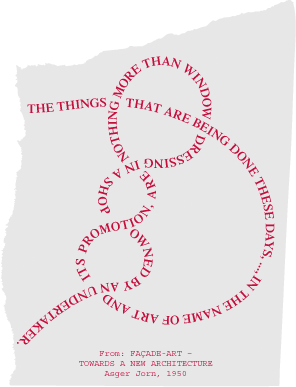
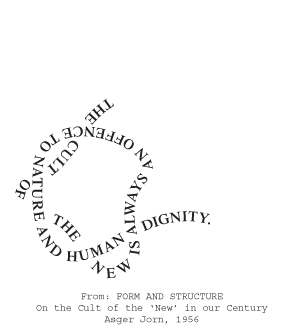
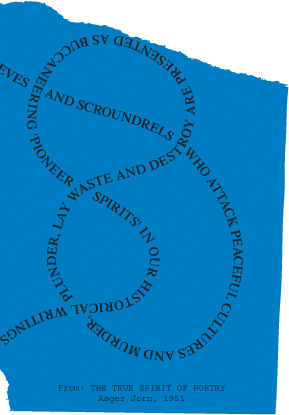
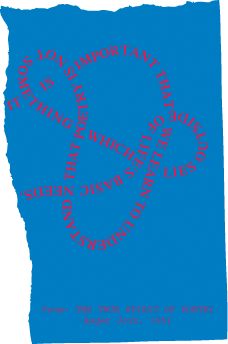
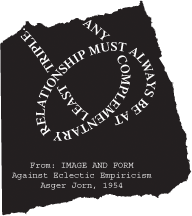
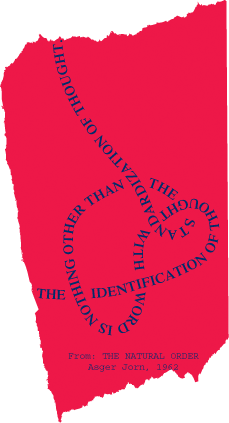
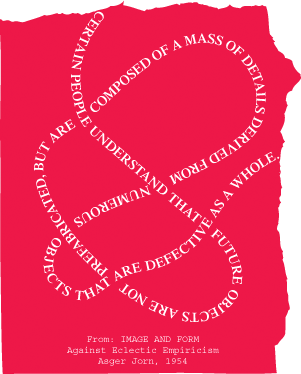
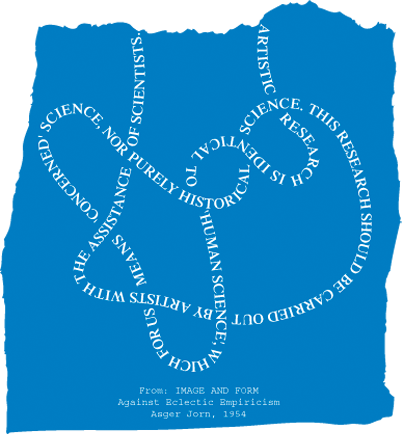
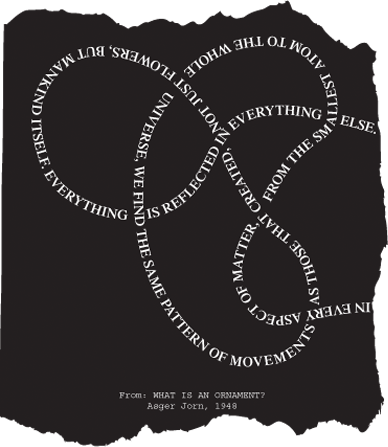
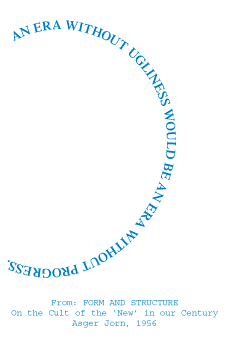
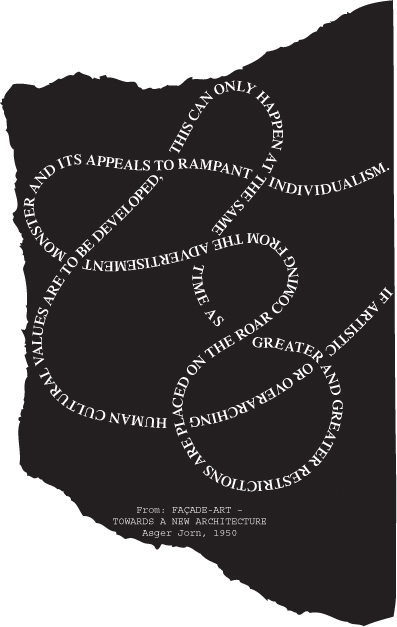
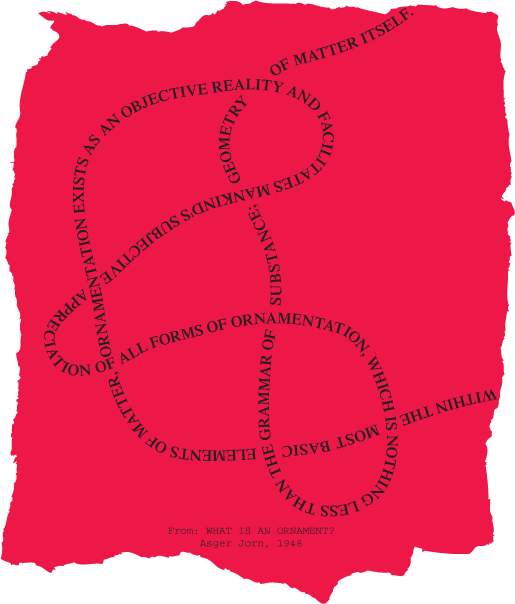
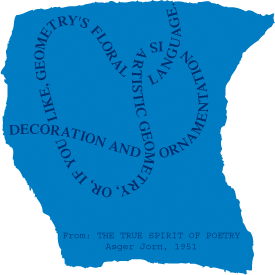
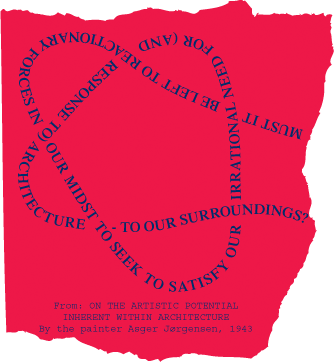
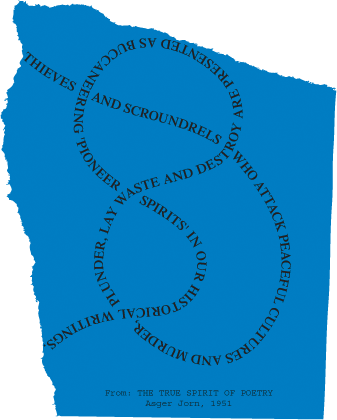
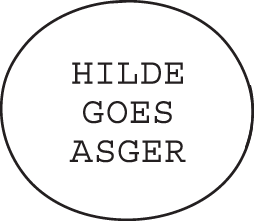
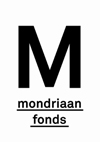
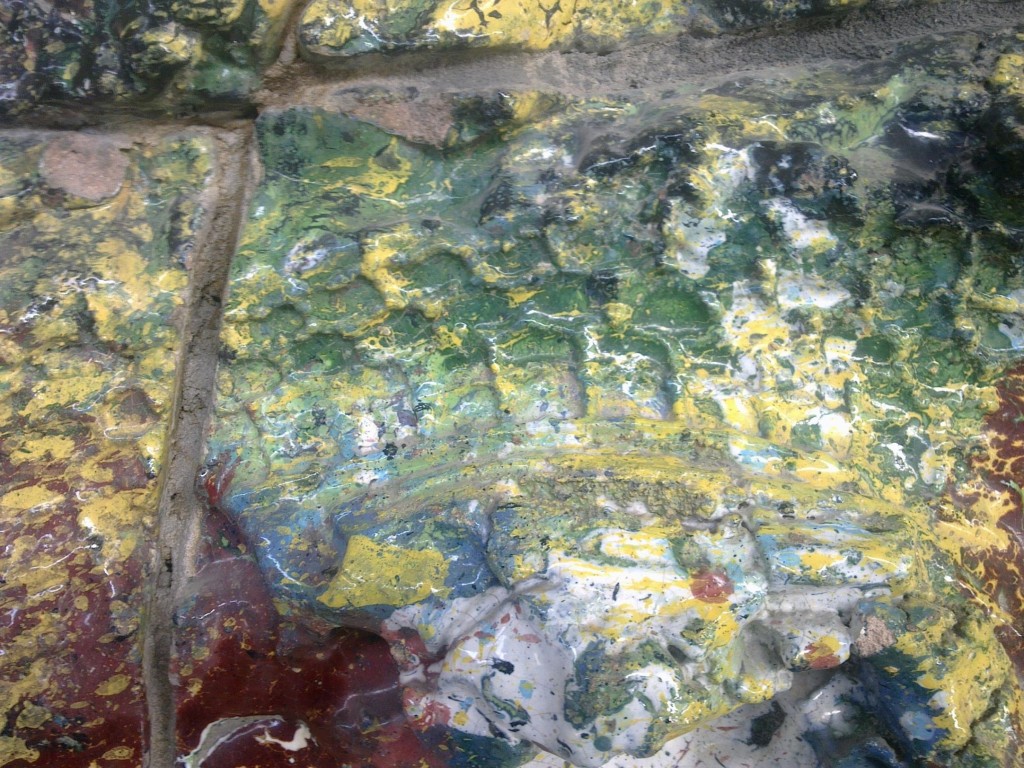
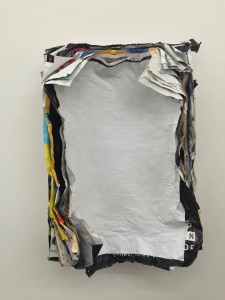

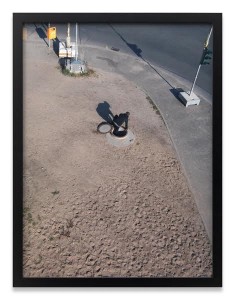
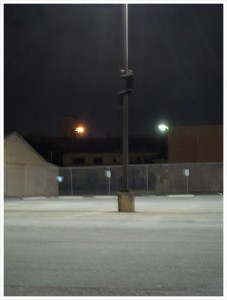
![775t[1]](https://www.hildegoesasger.org/wp-content/uploads/2015/07/775t1.jpg)
